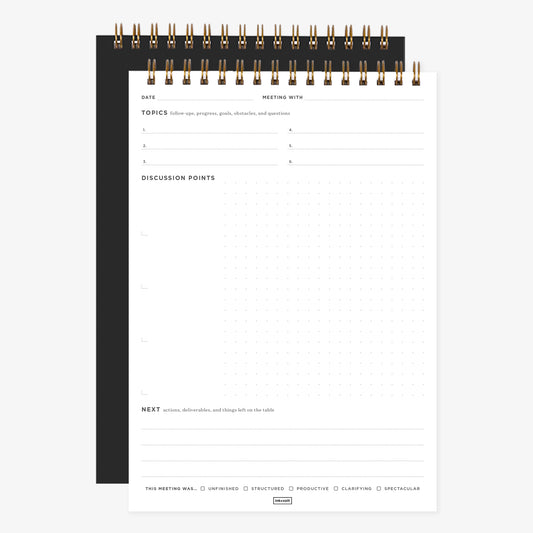Imagine this.
You’re dropped into the middle of an organization and you’re asked to put together a strategic roadmap for 100 teams made up of nearly 1000 people.
How do you start?
We love tackling big goals, and we love learning from people who have tackled big goals. That’s why we wanted to share this story from our friend who was given exactly this task at her new job and share her steps of what she did to accomplish her goal.
How would you tackle such a daunting task?
When the scale is so large, how does one person make an impact?
Read on to find out, step-by-step, how to make something so big happen.
The goal: create a roadmap for an existing 1000-person team
Being new in a job is hard to begin with. There is so much to learn — from new tools and software to meeting your coworkers to getting up to speed on existing projects — and you want to hit the ground running with it all.
Now imagine that on top of that, you actually have to step in and figure out what everyone else (all of whom have already been working there far longer than you) is supposed to be doing too.
The first step is to acknowledge the facts above: you don’t know as much as the people who already work there. Yes, you have your own experiences and skills to draw on, but you don’t really know what’s going on at this organization when you’re new — at all.
You can’t make a plan without any information. And it is important to accept that in this moment, you really don’t have any information (no matter how smart and experienced you are).
So how do you get the information you need?
How to do effective information-gathering
The first thing to do is to find the people with the information. Makes sense, right?
Identify the leaders and influencers who can get you up to speed
In order to identify the people who have the information you need, you can look at the org chart to start. You’ll want to talk to the people in charge, of course — your manager, your manager’s manager, the team leaders who you are managing, etc).
You’ll also want to look for the informal leaders too. These are the people who may lack an official title, but who everyone (even formal leaders) turn to for information, guidance, and insight.
You have probably known people like this — or maybe you have even been this person.
Forgetting to include informal leaders could cost you valuable information about how things work in your new organization. Since they often lack status and seniority, they tend to have information from within the team that formal leaders don’t have, since people aren’t often as candid with their boss as they are with their peers.
Once you have identified some key people to meet with first, you’ll want to set up meetings with them early on (like in your first week) and ask them questions to get yourself up to speed.
Some good questions to ask include:
- What are you working on?
- What are your biggest challenges?
- What are your biggest opportunities?
- What is it important for me to know?
- Who else from this team is important for me to talk to? (This is a great way to find the informal leaders!)
It’s a good idea to have a standard set of questions that you bring to every meeting, so that you can calibrate your responses without too much variation.
Aim for structure and block off reasonable time limits so that conversations don’t have too much opportunity to meander off course. Try to keep the meetings consistent — not tailored to each person — so that you have similar data from each meeting to study once you’re done.
Ask people for their roadmaps
Another strategy you can try when you’re getting to know the leaders and influencers in your new organization is to ask people what they would do in your situation.
After all, you are trying to get an idea of what really matters in the organization — plus, everyone loves being asked what they would do if they were in charge!
This is a great opportunity to learn from other people’s experience and perspectives. You will get more than just ideas too; this is also a great way to get to know what motivates the people who you will be working most closely with. What do they see as their biggest goals and challenges? How can you position yourself to be someone they want to see succeed?
You can make this a part of your regular list of questions, and collect everyone’s opinions as data. Look for trends and answers that are consistent across multiple people — this is a good sign that something is truly important.
(Consistent answers could also represent a widespread lack of understanding of an issue, which is just as important to know about if you want to create a plan that people will actually be willing and able to follow.)
How to structure your meetings to be as effective as possible
If you are really taking on the job of leading 1000 people on 100 different teams, then there are a lot of people for you to meet with. A lot. That takes time, and you need to be strategic with your most valuable resource: your time.
Start by setting timeline expectations with your manager
To start doing this process successfully, you’ll want to set expectations with your own manager so they know how and why you are spending your time.
Set a timeline for how long you think this process will take — or at least how long the initial phase of meetings will take — and how you will present your findings to them. It’s a good idea to check in often in the early stages, so plan to touch base after a week or two to share findings at first.
It’s important to keep your manager in the loop throughout this process, since you are still new to the team, and this is a critical time to build trust with them about how you are spending your time and where you are going.
Meeting with groups vs. 1:1
When you have dozens or hundreds of people to meet with in your first few months on a job, you need to be strategic about your time.
This is all about finding a balance between meetings that are valuable but also efficient.
There are pros and cons to 1:1 meetings. For example, meeting 1:1 is the best way to build rapport with someone, which is important to do when you are new, trying to establish trust, and needing to go fairly in depth on a topic.
On the other hand, 1:1 meetings take a long time if you have a lot of people to meet.
With a group, though, you can learn from several people at once; the challenge then becomes building a rapport with each person, as well as finding the ideal group size where it’s big enough to be helpful but not so big that it’s chaotic.
How to structure productive, efficient meetings
Our friend found that the best meetings were the ones she organized with small groups of carefully selected people. Of course, for certain meetings with key stakeholders, a 1:1 was still the most valuable; however, for getting through the bulk of the people she needed to meet, a small group helped her be swift but still get value.
For these meetings, she would ask each group to prepare a presentation. The group would work together to create it, which meant that they had to think through and unify their ideas in advance before the meeting, which helped keep the final conversation efficient and on track.
She would also outline specifications for what should be in the presentation, in order to get presentations that were as similar as possible from each group. That way — just like asking the same questions in every meeting — she could get consistent data points to compare.
Presenting your findings and creating a plan
Once you have completed an initial round of meetings (for example, after a week or two), it is critical that you start to share your findings with your manager and other leadership.
To prepare, you want to look at all the data you’ve collected and start to look for common points.
- What are the goals everyone agrees on?
- What are the challenges that come up across teams?
- Are there certain teams that stand out in any way?
At this point, you can also start to wrap in your own analysis and perspectives.
- What blind spots stand out to you that no one brought up?
- Where things appear to be going well or poorly to you, as an outsider, that people within the org had different opinions on? This could be a blind spot, or a place where you need more information to understand why they see it differently from you.
- What opportunities have you identified so far?
Structure your presentation in a way that distills the information in an easy way. Start by showing the org chart and identifying the people who you met with, and then explaining the themes of what you learned.
You can then move on to your own insights and suggestions, as well as questions that you still have that you’ll get answers on either in the meeting or in your continued meetings with team members. This is where you’ll start to build the foundation for your roadmap, which you will continue to do as you gather more and more information.
It is so important to acknowledge where you still have things you need to learn, because even with everything you’ve learned so far, you are still new and there is a lot of legacy knowledge that you will be acquiring.
Plus, running a 1000-person team is never going to be a “set it and forget it” kind of role where you can create a plan and trust that it will just keep working, so being flexible and open to new information shows you have the right mindset for this big job.
These lessons apply to your role today, no matter how big or small
One of the best things about seeing people do big things is taking away lessons that you can apply to your own life and career, even if you never actually have to manage 1000 people at once.
Here are 3 takeaways you can use right now, no matter what your job or goal is:
1. Acknowledge what you don’t know and create a plan to learn
It can be hard to admit when you don’t know something at work (and in life) — it is tempting to always say yes in the moment and figure it out later. But creating transparency is critical not only to building trust with your peers (who wants to be discovered not actually knowing the thing they said they knew?) but it will make you better and more valued at your job!
When you say you don’t know, it saves time because it gives people an opportunity to give you the tools or connections you need in order for you to understand. And once you understand, you can immediately start applying that knowledge to create value for the team. This is way faster and more meaningful than pretending to know something and having to find time in your schedule to try to teach yourself — which you may not even do effectively, wasting more time.
2. Create structure to take in new information quickly
When you have a lot to learn fast, information often feels like it’s coming in as a flood. That’s because the people and tools giving you advice or knowledge don’t know exactly what you need or how you need it, because they aren’t you — so they just tell you what they know.
By creating a plan for how you want to take in information, you will set yourself up to process it as efficiently and as effectively for you as possible.
3. Always communicate your process and results upwards
Sharing information with your boss is one of the most important ways (if not THE most important way) to build trust with them and ensure they see you as the superstar that you are.
Most people don’t realize that their boss has no idea what they do all day. But if you think about it, your boss has their own job and boss to worry about — they can’t monitor you every second. So they depend on the information that flows up to them about you and your work. Don’t you want to be in control of that flow of information?
When you make check-ins with your manager a regular part of your week, you also make sure that you always know what the most important things to work on are. (You can find this out simply by asking! A good manager will always appreciate that you want to be clued in on how to make the biggest impact.)
This way, you can constantly calibrate to make sure you are contributing in the most valuable ways possible — and you’ll also ensure your boss knows how much value you are adding, because you are showing them.
How do you tackle big goals? What would you do first if given the task of creating a roadmap for 1000 people in a new organization?









